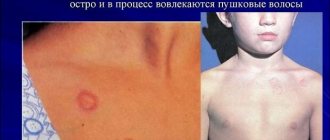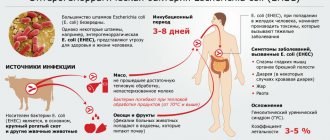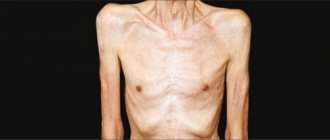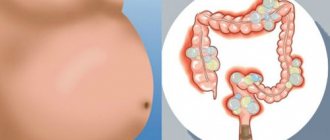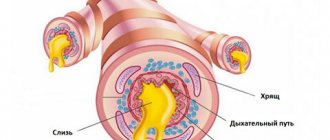Toxocariasis (toxocariasis) is a human disease caused by larvae of worms of the genus Toxocara from the order Ascarididae, parasitizing dogs (Toxocara canis), cats (Toxocara cati), and presumably cattle (Toxocara vitulorum).
Toxocariasis is a zoonotic disease. This means that the causative agents of such a disease (Toxocara helminths) during a normal life cycle live in the body of animals, but when they enter the human body, they can lead to serious consequences.
These two species of Toxocara T. Canis and T. Mystax are probably the most common worms in domestic animals (cats and dogs). There are many “accidental” (paratenic) hosts for these parasites. These include humans, birds, pigs, rodents, goats, monkeys and rabbits. In paratenic hosts, the larvae never mature and remain in the second stage of development. But it is interesting that in the organisms of their adult primary hosts, most parasite larvae also do not develop, but are encapsulated in a similar way (“will go into hibernation”) and are reactivated when the offspring appear in order to infect them.
Signs of toxocariasis infection depend on the number of larvae circulating in the blood and the affected organs, as well as on the host’s immune response. It is most difficult to recognize toxocariasis when it is asymptomatic or its symptoms are not pronounced. In this case, the course can be quite long, up to several years.
Treatment regimen for toxocariasis in adults
There is no single treatment regimen for toxocariasis in adults. The form of therapy is determined by the doctor based on clinical data, patient test results and instrumental studies. Self-medication for toxocariasis is unacceptable.
To combat toxocara, anthelmintic drugs are used. Their active ingredients may be Thiabendazole and Mebendazole. The drugs are taken in tablet form.
In most cases, the patient is prescribed Albendazole. If you use this drug, you will have to do a blood test. With its help, the progress of treatment is monitored in order to stop taking the medication in time if there is a threat of toxic hepatitis. Albendazole is taken for 1-2 weeks.
Vermox may also be prescribed. Treatment with this drug takes from 1 to 4 weeks. The advantage of Vermox is its good tolerability.
The treatment regimen also includes drugs that improve the general condition of the patient. These may be antihistamines, antipyretics or anti-inflammatory drugs. In the presence of multiple organ lesions, glucocorticoids are prescribed.
Toxocariasis in adult patients is often treated on an outpatient basis. Therapy in a hospital is indicated only in cases where the patient has serious damage to internal organs and systems.
When developing a treatment regimen for toxocariasis in adults , anthelmintic drugs are first prescribed. In particular, the following effective means are used:
- Albendazole. The drug effectively fights visceral and ocular forms of parasitic infection. At the same time, it has a moderate toxic effect on the body, so that manifestations of intoxication in the form of nausea will be minimal. The course of treatment with Albendazole is 10-20 days.
- Vermox. The dosage of the drug for adults is 200-300 mg per day in two doses. The duration of the course depends on the intensity of the infection, but not less than 2 weeks. These toxocara tablets provide minimal side effects.
- Ditrazine citrate. The drug actively fights against the parasite, but due to its toxicity, it also provokes side effects in the form of nausea, headache, dizziness, etc. The course of therapy with Ditrazine ranges from 2 to 4 weeks.
- Mintezol. The least toxic medicine that does not have a negative effect on the cardiovascular system and respiratory organs. Reviews about it are quite positive. The duration of treatment of toxocariasis using Mintezol is only 5-10 days.
Important: Albendazole is contraindicated for pregnant women in all trimesters.
To restore all body systems that have suffered from the waste products of the parasite, a number of other drugs are prescribed:
- Glucocorticoids. They relieve inflammation and neutralize allergic reactions that will definitely arise against the background of mass death of the worm. Such drugs include Dexamethasone, Prednisolone, etc.
- Adsorbents. Aimed at binding and effectively removing both toxins and dead parasites from the body along with feces. Excellent removal of toxins Smecta, Enterosgel, White Coal, Enterol, etc.
- Probiotics. These drugs are prescribed for the treatment of toxocariasis in humans in order to restore the intestinal microflora that has died under the influence of the active life of toxocaria in the human body.
- Electrolytes in the form of solutions. Indicated intravenously for patients with severe pathology to restore metabolic processes in the body.
Important: in the ocular form of toxocariasis, the patient is given subconjunctival injections to destroy toxocariatic granulomas. In extreme cases, the ocular form of toxocariasis is cured by surgical intervention.
Despite the information provided about the tactics of combating the parasite, only the attending physician should tell how to treat toxocariasis in an adult patient and how to treat the pathology. Self-medication can lead to minimal therapeutic effect. At most, the situation will worsen. In this case, a person’s symptoms may even be vague.
Take a test for worms
Symptoms in humans
Physiological responses to the spread of Toxocara larvae throughout the body depend on the host's immune response and parasitic load. Symptoms may appear only in the second stage - when migration begins. In most cases, toxocariasis is asymptomatic, especially in adults.
Visceral form
The most common type of disease is when a relatively large number of toxocara enter the body. They most often affect the lungs, liver, and cardiovascular system. Classic symptoms include:
- fever, usually up to 37.5 degrees, but can be higher, chills (especially if the lungs are infected);
- general weakness, lethargy;
- abdominal pain, vomiting, diarrhea;
- sore throat, cough, shortness of breath, even bronchitis or bronchopneumonia;
- rash on the skin;
- enlarged liver, painful sensations in the right hypochondrium, and the spleen may also enlarge;
- enlarged lymph nodes.
If the disease continues for a long time, anemia (decreased hemoglobin in the blood) may occur.
Ocular toxocariasis
It is much less common than the visceral form (about 10 times). It is believed that the cause is an insufficient immune response that is unable to prevent the larvae from entering the eye. With this form, one eye is most often affected. The larvae, entering the choroid of the eyeball, form characteristic granulomas (nodules) in the retina or lens. Inflammation of the visual organ always occurs, and it occurs in a chronic form. Keratitis (inflammation of the cornea), endophthalmitis (purulent inflammation of the membranes of the eye), retinal detachment, optic neuritis, or complete blindness may develop.
Granulomas (encysted Toxocara larvae) inside the eyeball
Cutaneous form
It is characterized by an allergic reaction, which can manifest itself in the form of urticaria and eczema. In this case, the person feels severe itching, redness and swelling occur on the skin. Symptoms may be observed first in one place and then in another, due to the migration of larvae.
Neurological toxocariasis
It appears when helminths penetrate parts of the central nervous system. This is a dangerous form of infection as it can lead to inflammation of brain tissue. Granulomas can also form in it. The very first symptoms are headaches and cramps.
Other signs of this form of the disease include changes in a person’s behavior and mood, irritability, and memory impairment. There may be difficulties when trying to read something or concentrate. In some cases, convulsions and epileptic seizures occur. Without treatment, the consequences are more serious.
Hidden form
Latent toxocariasis is the least serious, but has a chronic course. Signs and symptoms include cough, fever, abdominal pain, headaches, as well as changes in behavior and sleep disturbances. Examination often reveals rales, hepatomegaly (enlarged liver), and lymphadenopathy (enlarged lymph nodes).
Treatment regimen for ocular toxocariasis
The treatment regimen for ocular toxocariasis is selected individually. Therapy takes into account the size of the affected area and the location of the larva. Patients are prescribed photo- and laser coagulation. Thanks to these procedures, the shells containing the parasite larvae are destroyed.
Inflammation of the eyeball is relieved with Depo-Medrol. It is used in the form of subconjunctival injections. Also, thanks to this drug, the larvae are eliminated.
Sometimes Depo-Medrol is ineffective. In this case, anthelmintic drugs are prescribed.
For some forms of ocular toxocariasis, surgical intervention is possible. This treatment method is used when retinal detachment develops.
Inflammation of the eyeball is relieved with Depo-Medrol. It is used in the form of subconjunctival injections.
Forms of toxocariasis
There are 3 main forms of toxocariasis based on the affected organs and the manifestation of symptoms:
- Visceral form - includes diseases associated with major organs. This is a fairly wide range, so sometimes damage to the skin and central nervous system is taken out separately.
- Hidden form - represents the essence of the previous one, but the symptoms are milder or absent altogether.
- Ocular form – pathological effects affect the eyes and optic nerves.
Traditional treatment
If toxocariasis is detected in an adult patient, treatment with folk remedies can also be carried out, but only with the approval and consent of the attending physician. So, treatment of toxocariasis with folk remedies is carried out using the following herbs and ingredients:
- Garlic. To prepare a remedy against parasites, you should boil one head (not a clove) of crushed garlic in a liter of milk and then, after cooling the mixture, use it to give an enema. A total of 7 such cleanses need to be done within a week. That is, 1 enema per day.
- Tansy. Flowers and leaves of the plant in the amount of 3 tablespoons are poured into 250 ml of boiling water and the mixture is infused for about an hour. Then strain the product and take 1 tablespoon 3-4 times during the day.
- Wormwood (seeds). The plant in the amount of 1 tablespoon is mixed with honey and eaten in between meals.
Important: folk remedies for toxocariasis should not be used on children. However, it is worth remembering that toxocariasis in an adult cannot be completely cured even with these methods. Especially if the infection is quite powerful (a large number of worms in the body).
When is it advisable to be examined for toxocariasis?
- 1Long-lasting, unproductive cough after acute respiratory viral infection, not of chlamydial, viral or mycoplasma nature;
- 2 Frequent obstructive bronchitis or bronchial asthma in children, with nocturnal attacks of suffocation and shortness of breath, especially against the background of severe eosinophilia;
- 3 Vague abdominal pain, stool instability;
- 4 Long-term low-grade fever with general asthenia and neuroticism;
- 5Peripheral lymphadenopathy in children;
- 6Decreased vision in one or both eyes, the presence of scotomas not due to other reasons;
- 7 Severe eosinophilia, which cannot be explained by an allergic nature (this is 20% or more);
- 8 Papular and urticarial allergic skin rashes in children and adults, especially with a good history of allergic diseases.
- 9When several factors listed above are combined, the likelihood of toxocariasis increases.
Pathogen
The causative agents of toxocariasis are two species of parasitic roundworms of the genus Toxocara, which belongs to the class Ascarididae. Representatives of the cat family are the only hosts of the cat toxocara (T. cati), and dogs, foxes and other canines are the only hosts of the canine toxocara (T. canis).
The main causative agent of the disease in humans is still considered to be canine toxocara, which is why it is more common. It is also assumed that toxocariasis can be caused by Toxocara vitulorum, although there is no reliable evidence of this. Methods for diagnosing toxocariasis, which are usually used, do not allow us to specifically determine the type of parasite whose larvae caused the disease.
Toxocara under high magnification
5. Diagnosis of helminthiasis
Diagnosis of toxocariasis includes collecting information about the patient:
- 1A thorough survey of the patient or parents if the child is sick (collecting a medical history): when the listed complaints appeared (abdominal pain, stool disturbances, malaise, broncho-obstruction, cough, fever), how the disease arose (sharply or acutely). Are hygiene measures carried out correctly in the home and in the patient’s home (this applies in most cases to children, whether nails are cut, how often hand washing is done).
- 2Analysis of daily activity data (life history): is there a connection between the patient’s profession and risk groups for this pathology (veterinarians, gardeners, utility workers), whether there are four-legged pets (cats or dogs), the conditions in which they are kept, whether there were similar symptoms before or disease in this patient.
- 3General examination, palpation, percussion, auscultation, testing.
5.1. Laboratory research methods
A general blood test is often characterized by the following changes:
- 1Eosinophilia (relative, less often absolute). Toxocariasis is characterized by a significant increase in the number of eosinophils (20% and above);
- 2 Accelerated ESR, general leukocytosis.
Changes in biochemical blood test:
- 1Hyperbilirubinemia;
- 2Hypergammaglobulinemia;
- 3Dysproteinemia;
- 4Increased levels of AST, ALT, GGTP, alkaline phosphatase.
5.2. Serological reactions
Serological reactions are one of the main methods for diagnosing toxocariasis and are aimed at identifying specific antibodies: IgG and IgE to T. canis antigens. The most commonly used method is enzyme-linked immunosorbent assay (ELISA).
When identifying specific IgG, it is necessary to determine their avidity. High avidity indicates a previous disease or long-term invasion. A low degree of avidity is observed with recent infection and acute toxocariasis.
In Table 2 below we have summarized the capabilities of some laboratories in detecting specific antibodies.
| Laboratory name | What determines and by what method? | Decoding the results |
| Laboratory KDL | Determination of specific IgG to Toxocara canis (anti-Toxocara IgG) by ELISA | * Less than 0.9 KP – not detected; * 0.9-1.1 KP – doubtful; * More than 1.1 KP - positive |
| Laboratory Invitro | IgG antibodies to Toxocara antigens (anti-Toxocara IgG) by ELISA | * Less than 1.0 – negative; * 1.1 - 4.4 – weakly positive; * More than 4.4 – positive |
| Helix Laboratory | IgG antibodies to Toxocara by ELISA | * 1:100 – diagnostic titer * Less than 1:100 – negative; * 1:200 - 1:400 - doubtful * 1:800 and above - positive |
| Other laboratories may have their own reference values | ||
Table 2 - Evaluation of ELISA results for toxocariasis in different laboratories.
Is it possible to establish a diagnosis of invasion based on serological reactions? Let's look at the main cases when we can confidently say about toxocariasis:
- 1There are bronchopulmonary symptoms and rashes. The content of total IgE is increased, and significant eosinophilia is observed. The titer is 1:800 or higher, or exceeds the diagnostic one by 4-6 or more times. In this case, treatment of toxocariasis is required with one of the anthelmintic drugs (we will consider them below).
- 2The same symptoms are present. Title 1:800 and above. Eosinophilia is absent or moderate. The diagnosis is probable, specific treatment is indicated.
- 3The same symptoms are present. Titer 1:200-1:400. Eosinophilia is absent or moderate. The diagnosis is doubtful, the patient is registered. An examination by an ophthalmologist is required.
- 4No symptoms. Title 1:200. Eosinophilia is absent or moderate. The patient needs to consult an ophthalmologist. If there are no changes in the fundus, the patient is observed by an infectious disease specialist with repeated results after 6 months.
- 5There are ophthalmological symptoms. Titer 1:100-1:200. Eosinophilia is absent or insignificant. The final diagnosis of ophthalmotoxocariasis must be confirmed by an ophthalmologist.
- 6Toxocara carriage is a clinical situation in which a person has a positive titer of anti-toxocara-IgG (in the region of 1:200-1:400, but below 1:800), while the patient does not experience any symptoms of infection. Such persons are subject to dynamic monitoring with repeated ELISA tests and regular examinations. There is evidence that toxin carriers are prone to increased allergization of the body.
Instrumental diagnostic methods:
- 1X-ray of the lungs in two projections;
- 2FVD assessment;
- 3Bronchoscopy;
- 4Magnetic resonance and computed tomography according to indications, more often with a neurological form;
- 5 Ultrasound of the abdominal organs;
- 6Ophthalmoscopy;
- 7 Less commonly, biopsy with histological examination.
How dangerous are Toxocara larvae to humans?
The main danger of Toxocara larvae is the occurrence of systemic allergic reactions with characteristic manifestations. Also, given the peculiarity of sedimentation in various organs and the ability to form inflammatory infiltrates - granulomas - around themselves, there is a danger of dysfunction of the affected organs and systems (liver, kidneys, visual organs, thyroid gland, brain and others).
We must not forget that settled and “silent” at first glance larvae, when the body’s defenses decrease, can again resume migration and appear in another organ, disrupting its functional state.
The concept of toxocariasis and the causes of its appearance
Human toxocariasis
Toxocariasis is an infection with Toxocara roundworms, which spread throughout the human body, causing complications. Adult parasites reach up to 20 cm in length and live for about 4 months. The infestation is typical for representatives of the canine genus, but other animals can also become infected with helminths. People are no exception; Toxocara larvae reach humans in the following ways:
- From an infected pet;
- Through soil and food containing parasite eggs.
Eggs enter the soil and other surfaces with dog feces, remaining viable for a long time. The risk of infection is especially high for young children, since they often play in the sandbox, tinker in the ground, and pet animals with the spontaneity inherent in children. Naturally, before the procedure of basic hand washing, the child can touch his face or mucous membranes. Dog owners and people whose professional activities involve animals and the earth are also susceptible to infection. This category includes veterinarians, farmers, amateur gardeners, etc.
The development mechanism looks like this:
- Worm eggs enter the body after accidental ingestion;
- In the small intestine, Toxocara eggs pass into the larval stage (the small size of the larvae allows them to move to the liver and heart through the bloodstream);
- From the heart, helminth larvae are spread through the circulatory system throughout the body (parasites can remain in the vessel, developing further in it, or migrate to nearby organs).
The movement of helminths leads to tissue destruction, blockage or rupture of blood vessels. Toxocara can be located in any organ, under the skin, in the brain, causing disruption of basic functions. Individuals that die inside their own capsules degenerate into cystic formations, pseudotumors, and become the cause of constant intoxication.
Life cycle
Cats and dogs can become infected with Toxocara by eating eggs or by passing the larvae from a mother to her offspring. Transmission can also occur when larvae enter from infected accidental hosts - earthworms, cockroaches, rodents, rabbits, chickens, sheep.
Further development is similar to the human roundworm. Inside the intestine, the eggs hatch into larvae in the second stage of development. Although there is controversy over the appearance of a second or third larval form. They enter the bloodstream and migrate to the lungs, where they are coughed out and re-swallowed. They then mature into adults within the small intestine of a cat or dog.
Mating and laying also take place there. The eggs are passed in the feces and become infective only after several weeks outside the host. During this period, the development of the first to second (and possibly third) stage of the larva inside the egg occurs, i.e. maturation.
In most adult dogs and cats, the full life cycle does not occur, but the second stage larvae are encapsulated after a period of migration by the body. Only pregnant or lactating cats and dogs have active larvae. The complete life cycle usually occurs only within such females and their offspring.
A second form of larvae also hatches in the small intestine of an accidental host, such as a human, after ingesting infective eggs. They then migrate through organs and tissues - most often to the lungs, liver, eyes and brain. Since the larvae cannot mature in the bodies of accidental hosts, after their migration they get stuck in the blood vessels and penetrate into neighboring tissues, where they become encapsulated.
Prevention
Preventive measures for toxocariasis are as follows.
- Activities aimed at sources of invasion: examination and timely deworming of dogs, limiting the number of stray dogs, equipping special areas for walking dogs and their hygienic maintenance.
- Influence on infection transmission factors: washing hands after contact with soil and animals, thoroughly washing greens, berries, vegetables that are contaminated with soil, protecting sandboxes with film or shields from visiting animals, regularly changing sand in children's sandboxes (3 times a year), protection of parks and squares from free walking of dogs, arrangement of walking areas and their hygienic maintenance.
- Sanitary educational work - explaining possible ways of infection by parasites, methods of treating animals, the need to eliminate fecal contamination by dogs while walking them.
It is possible to defeat parasites!
Antiparasitic Complex® - Reliable and safe removal of parasites in 21 days!
- The composition includes only natural ingredients;
- Does not cause side effects;
- Absolutely safe;
- Protects the liver, heart, lungs, stomach, skin from parasites;
- Removes waste products of parasites from the body.
- Effectively destroys most types of helminths in 21 days.
There is now a preferential program for free packaging. Read expert opinion.
Interesting to know:
Can the parasite affect the liver and eyes?
When migrating, the larvae can be localized in the liver, heart, lungs, eyes, brain, muscles, pancreas, and they can maintain their viability for years without showing any symptoms. Activation of the parasite occurs, as a rule, with a sharp decrease in immunity; if this does not happen, then the larvae become encapsulated and die.
Parasite in the eye
Bibliography
- Centers for Disease Control and Prevention. Brucellosis. Parasites. Link
- Corbel MJ Parasitic diseases // World Health Organization. Link
- Young EJ Best matches for intestinal parasites // Clinical Infectious Diseases. — 1995. Vol. 21. - P. 283-290. Link
- Yushchuk N.D., Vengerov Yu.A. Infectious diseases: textbook. — 2nd edition. - M.: Medicine, 2003. - 544 p.
- Prevalence of parasitic diseases among the population, 2009 / Kokolova L. M., Reshetnikov A. D., Platonov T. A., Verkhovtseva L. A.
- Helminths of domestic carnivores of the Voronezh region, 2011 / Nikulin P. I., Romashov B. V.
An article for patients with a doctor-diagnosed disease. Does not replace a doctor's appointment and cannot be used for self-diagnosis.
The best stories from our readers
Topic: Parasites are to blame for all troubles!
From: Lyudmila S. ( [email protected] )
To: Administration Noparasites.ru
Not long ago my health condition worsened. I began to feel constant fatigue, headaches, laziness and some kind of endless apathy appeared. Problems also appeared with the gastrointestinal tract: bloating, diarrhea, pain and bad breath.
I thought it was because of the hard work and hoped that it would go away on its own. But every day I felt worse. The doctors couldn’t really say anything either. Everything seems to be normal, but I feel like my body is not healthy.
I decided to go to a private clinic. Here I was advised, in addition to general tests, to get tested for parasites. So in one of the tests they found parasites in me. According to doctors, these were worms, which 90% of people have and almost everyone is infected, to a greater or lesser extent.
I was prescribed a course of antiparasitic medications. But it didn’t give me any results. A week later, a friend sent me a link to an article where some parasitologist shared real tips on fighting parasites. This article literally saved my life. I followed all the advice that was there and after a couple of days I felt much better!
Digestion improved, headaches went away and the vital energy that I so lacked appeared. To be sure, I took the tests again and no parasites were found!
Anyone who wants to cleanse their body of parasites, no matter what types of these creatures live in you, read this article, I’m 100% sure it will help you! Go to article>>>
Still have questions? Ask them in our Anonymous group on VK
How to get rid of parasites in a week. The answer is here!
A reliable and effective remedy for combating worms. Removes all parasites in 21 days.
Go to website
Reviews
Read online
Symptoms that 100% indicate parasites! Take the Test.
How to rid your body of life-threatening parasites before it’s too late!
Read more
Website
To get a consultation
The doctor tells how to quickly get rid of parasites for adults and children!
A parasitologist explains what effective methods exist to combat helminths.
More details
Read completely
Comments
Search for cures for parasites
This service is a small help in finding cures for parasites. To start using it, select the type of parasite. If you don’t know what kind of parasite you are infected with, this parasite identification tool will help you by symptoms.
We recommend reading
A child grinds his teeth in his sleep: is it worms? And what other reasons are there?
4 days ago 01/29/202102/1/2021ecoliv94
Worms from sushi and rolls: can they appear and how not to get infected?
01/09/202111/01/2021ecoliv94
Worms on ultrasound: what worms look like in the abdominal cavity, liver on ultrasound
01/09/202111/01/2021ecoliv94
Can lymph nodes enlarge due to worms, is there a connection?
01/08/202111/01/2021ecoliv94
Are toxocara worms?
Toxocars are divided into the following types:
What to do in such a situation? To get started, we recommend reading this article. This article describes in detail methods of controlling parasites. We also recommend that you consult a specialist. Read the article >>>
- Toxocara canis , which is carried by dogs;
- Toxocara cati , which is carried by cats;
- Toxocara vitulorum , which is carried by cattle (cows, buffaloes).
These worms belong to the nematodes (roundworms). The most common species is Toxocara canis. These worms are of different sexes, with females significantly exceeding males in body length: 6-18 cm in females and 4-10 cm in males.
The body color is yellowish. The mouth opening is equipped with three lips; at the “head” end of the body there are bulges similar to peculiar “wings”, the size of which is used for differential diagnosis with other helminths, in particular with roundworms (see photo).
Toxocara under high magnification
Toxocara lay very small, round brown eggs measuring 65-75 microns in size. The eggs have a dense outer shell, and inside, if the egg is sufficiently formed, there is a mobile larva. If the formation of the egg has not yet been completed, then instead of a larva, there is a spherical embryo inside the egg.
Toxocara eggs
Toxocariasis is a geohelminthiasis because the eggs mature and are on the ground before reaching the host. Natural carriers of this helminth include predators of the cat and canine families (dogs, foxes, etc.), which act as the final hosts, while humans are an intermediate host for Toxocara.
Toxocara in cats and dogs
Toxocara in cats and dogs is a very common phenomenon and a source of infection for humans. Parasite eggs enter the body of animals from the soil, by eating raw meat and even earthworms. Another way is intrauterine infection, when the larvae penetrate the placenta and infect the fetus. Toxocara can enter the baby's body through mother's milk.
The entire development cycle of sexually mature individuals from an egg takes 3 weeks in the animal’s body, so toxocariasis can be diagnosed in puppies infected in utero after 3 weeks.
As a rule, adult cats and dogs do not show symptoms of the disease, but in puppies and kittens the signs of infection look like this:
- restless behavior, biting;
- diarrhea and vomiting, in which sometimes balls of toxocara come out;
- bloating;
- perversion of appetite;
- poor weight gain;
- developmental delay.
Kittens become infected through their mother's milk. In addition to the symptoms listed, they may experience dehydration and a dry cough; the eyes become sunken and watery; mucous membranes turn pale.
Only a veterinarian will give qualified advice on how to get rid of toxocariasis - self-medication can negatively affect the animal’s body. It is necessary to treat toxocariasis in animals, as children and people with weak immune systems can become infected.
Blood ELISA for igg antibodies: positive, negative and what it means
Among serological tests, ELISA is considered the most reliable, since it can be used to determine whether there are antibodies in the blood to the antigens of certain parasites. A positive result is if the igg titer is above 1:200; values from 1:200 to 1:400 indicate the presence of toxocara in the body, and antibody titers above 1:600 indicate the development of the disease and the need for urgent treatment.
ELISA is a very reliable method (up to 95%), and its price is not so high - from 300-350 in regional centers to 550-600 in Moscow and St. Petersburg.
